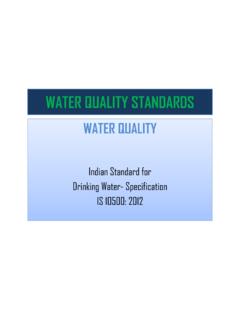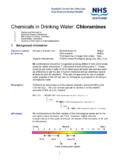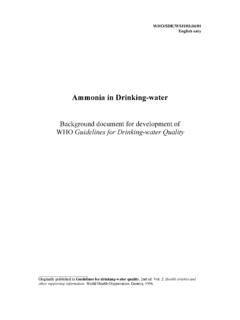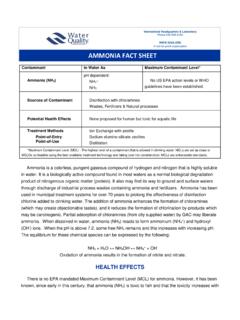Transcription of Quick Guide To Drinking Water Sample Collection - Second ...
1 United States Region 8 Laboratory September 2016 Environmental 16194 W. 45th Dr. Protection Agency Golden, CO 80403 Quick Guide To Drinking Water Sample Collection Second Edition, Update 2 Disclaimer This document provides a general summary of techniques used by EPA Region 8 Laboratory staff for the Collection of chemistry samples for Drinking Water analysis. Other approaches to Sample Collection may be acceptable or desirable under given conditions. This document is intended as a refresher for those already trained in Sample Collection .
2 The user is urged to check with the laboratory performing the analysis to ensure that the bottles, preservatives, and holding times which are to be employed are compatible with the methods used by the laboratory. The Second edition corrects and expands on the guidance for sampling Water lines for compliance with the lead/copper rule. The first edition should not be used. The Second edition also updates sampling techniques for total coliforms and E. coli and provides a reference for the Revised Total Coliform Rule.
3 In addition, it contains minor editorial corrections and updates. The Second edition update expands on the guidance for sampling Water lines for compliance with the lead/copper Table of Contents Section Page General Sampling 4 Specific Sampling Procedures 6 Biological Contaminants Bacteria and 7 Total Coliform and E. 8 Cryptosporidium and 9 Classical Chemistry Constituents and Nutrients (IOCs) Unpreserved Nutrients, Anions, 10 Preserved Nutrients, Anions, 11 12 Colorimetric Analysis for Disinfectant 13 Haloacetic Acids (HAA5s).
4 14 Metals (IOCs) Common Metal 15 16 Semivolatile Synthetic Organic Compounds (SOCs).. 17 Total Organic Carbon (TOC).. 18 Volatile Organic Compounds (VOCs) Common 19 Total Trihalomethanes (TTHMs).. 20 4 General Sampling Procedures This summary document is designed to be used by personnel trained in the Collection of Drinking Water samples and handling of Sample preservatives. Follow the procedures described below to assist in the Collection of an acceptable Sample and to maintain the integrity of the Sample after Collection .
5 1. Prepare a Sampling and Analysis Plan (SAP) which describes the sampling locations, numbers and types of samples to be collected, and the quality control requirements of the project. 2. Check with the laboratory before collecting samples to ensure that sampling equipment, preservatives, and procedures for Sample Collection are acceptable. It is best to obtain sampling supplies directly from the laboratory performing the analyses. Gather all equipment and supplies necessary for the project. 3.
6 The acids and bases used in preservation of many types of samples described in this document are dangerous and must be handled with care. Always wear gloves and eye protection when handling preservatives. When opening a preservative bottle, particularly a glass ampoule, break open the ampoule away from yourself and others. Have acid/base neutralization supplies (baking soda) on hand in the event of a spill. If acid spills on your skin or clothing, remove the contaminated clothing and rinse the area with Water .
7 Do not apply baking soda (the heat of reaction can cause burns). 4. Collect samples in an area free of excessive dust, rain, snow or other sources of contamination. 5. Select a cold Water faucet for sampling which is free of contaminating devices such as screens, aeration devices, hoses, purification devices or swiveled faucets. Check the faucet to be sure it is clean. If the faucet is in a state of disrepair, select another sampling location. 6. Collect samples from faucets which are high enough to put a bottle underneath, generally the bath tub or kitchen sink, without contacting the mouth of the container with the faucet.
8 7. Open the faucet and thoroughly flush. Generally 2 to 3 minutes will suffice, however longer times may be needed, especially in the case of lead distribution lines. Typically the Water temperature will stabilize which indicates flushing is completed. Once the lines are flushed, adjust the flow so it does not splash against the walls of the bathtub, sink or other surfaces. 5 8. Follow the Collection instructions provided for the analytes of interest described on the following pages. Wear eye protection and gloves if you are handling containers with acidic/basic preservatives and when you are collecting samples.
9 9. Lead and Copper Rule Compliance Samples: Select a cold Water faucet for sampling which is free from devices that are designed to change the Water composition, such as Water softeners or point of use filters. DO NOT remove any screens or aeration devices. If you are collecting a first-flush Sample for lead/copper, allow the Water to sit undisturbed for at least six hours. DO NOT intentionally flush the Water line before the start of the 6 hour period. Place a wide-mouth 1 L bottle under the faucet.
10 Open the faucet and collect the first Water out of the tap. If you want to test a lead service line then 8 to 10 sequential Sample bottles (the number depends on how far the lead service line is from the tap) would be needed to see the profile of lead distribution. For more detailed sampling instructions, refer to the EPA s Clarification of Recommended Tap Sampling Procedures for Purposes of the Lead and Copper Rule at: 10. Fill out the chain of custody form with the Sample Collection information.


















